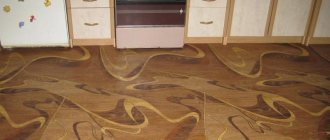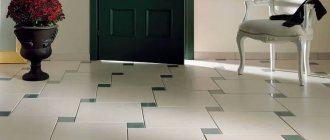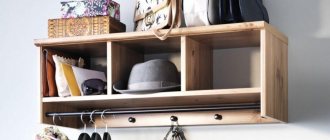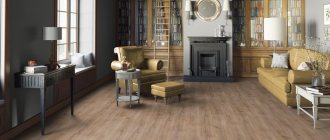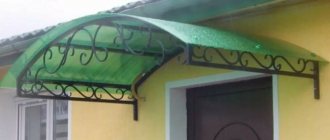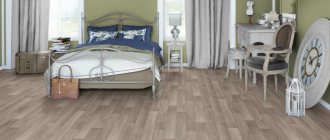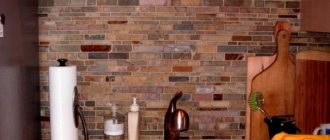Linoleum is a well-known material that has a wide range of applications in industry and in everyday life. It is used in the design of private interiors, administrative buildings, cafes, restaurants, offices. There is such a variety of floor coverings on the shelves of modern stores that it is difficult to manage without the help of specialists and a design approach.
When choosing a floor covering, you should start with a logical question: does linoleum fit into the interior, combine with wallpaper, and the ceiling?
The coating has a color, pattern, and texture that should match the design of the room for which linoleum is being selected. The material has varying wear resistance; not every type of linoleum can withstand significant load on the coating.
- From the history
- Advantages and disadvantages
- Varieties Natural
- PVC
- Relin or rubber
- Alkyd
- Domestic
- In the kitchen
From the history
Linoleum appeared in the history of decor a long time ago, and to this day has not lost its popularity. At the time of its creation back in 1627, it was a durable oiled fabric. The term itself comes from a combination of the words “linen” and “oil” (linum + oleum). Therefore, the first coating of this nature was a natural material. The idea to patent the product came to Nathan Smith in 1763. Since 1843, additional natural substances began to be added to the fabric.
Today, the composition of linoleum has several layers. Polyvinyl chloride is a thick base layer that allows you to maintain its basic properties: sound insulation, heat retention in the apartment, moisture resistance, etc. Fiberglass and polyurethane are responsible for the strength of the material. The products are produced in the form of rolls; in domestic conditions they are laid using the laying method; in industrial premises they are fixed with glue and mastic.
Advantages and disadvantages
The advantages of linoleum outweigh the disadvantages. It has a low price, elasticity, moisture resistance, and low maintenance. A huge number of colors, patterns, decorative elements. It has a long shelf life - 15-25 years, much depends on the foot traffic of the room. Natural linoleum has positive characteristics in terms of environmental safety.
The disadvantages of certain types of material include increased toxicity, tendency to deformation, and drying out. Higher quality linoleum has good characteristics, but its main disadvantage is its high price.
Varieties
There are a large number of varieties of linoleum, differing in material of manufacture and nature of application. At first glance, it can be difficult to determine how they differ. In most stores there is no obvious division, it is easy for the average buyer to get confused, but upon closer examination the difference turns out to be significant.
Household, commercial and semi-commercial linoleum belongs to the same type, the differences are in the thickness of the coating and protective layer, in the areas of application: commercial - for non-residential premises, household - for home use. Some classifications also distinguish between stage and ballet linoleum with an ideal matte, glossy surface, which allows you to adjust the lighting in the work area with maximum precision and achieve the desired design effect. It has high sound and noise-absorbing characteristics, creating favorable conditions for creativity. Sports surface is a type of commercial surface and has its own production technologies.
For example, to determine which material is of high quality and which is not, you can conduct an experiment. Ask the store for a small piece of each type of flooring, place each one under a chair leg and sit on it for a while. Soon, marks and dents will appear on cheap, low-quality linoleum, while more wear-resistant material will remain unchanged.
Natural
Natural linoleum is made from limestone, special fiber, linseed oil, tree resins, cork and wood flour, and natural dyes. This type of material belongs to the premium class and has a specific smell that disappears a few weeks after installation. The shelf life of the coating is up to 30 years.
If people living in an apartment suffer from allergies, bronchial asthma, and other respiratory diseases, natural linoleum is the best option for flooring. The natural material has bactericidal properties, does not fade in the sun, and does not support combustion, thanks to its natural impregnation.
Eco-design and eco-materials are actively entering our lives today; people pay more attention to the impact of coatings on the environment.
The disadvantages of this type include fragility, excessive susceptibility to deformation, and high price.
PVC
The most common type of linoleum, which can be found on every counter of construction stores. It is made of fiberglass, on a fabric or non-woven basis, it can be single-layer or multi-layer. It has low thermal conductivity, is resistant to abrasion, is environmentally friendly, and is not susceptible to rotting or fungus. PVC is easy to install and comes in many colors.
PVC linoleum also has disadvantages. It does not tolerate high temperatures and exposure to solvents. At low temperatures it loses its elasticity. According to the structural composition, PVC linoleum can be homogeneous or heterogeneous. The first has a homogeneous structure and consists of one layer.
During the production of the material, quartz sand and lime are added. The more fillers, the cheaper the coating and the shorter the service life.
Heterogeneous linoleum has several functional layers. The bottom one is the backing, designed to protect against pressure, impacts and other loads. The basis of the PVC coating is fiberglass. Adds elasticity to the product and prevents deformation. The next layer is decorative. The top one is PVC in its pure form, protects the material from abrasion.
Relin or rubber
Relin, or rubber linoleum, has a lining made from a mixture of crushed rubber and bitumen. The front layer is made by mixing rubber, filler, and pigment. It has high elasticity, moisture resistance, and resistance to aggressive detergents and chemicals.
It is used in indoor and outdoor public spaces, swimming pools, and sports fields. It has good adhesion to sports shoes, is comfortable and safe to use. Not susceptible to scratches or damage from sharp objects.
Relin cannot be used in residential premises due to environmental unsafety. The material contains harmful volatile substances.
Alkyd
Alkyd or glypthal coating is made by applying an alkyd resin to a fabric base. Contains oils, fillers, pigment, and sometimes an antiseptic. Supplied in a large assortment, with different colors, patterns, textures. Most often used in technical and public spaces, it has good heat and sound insulation properties. Compared to PVC it has higher mechanical properties.
Linoleum is fragile and difficult to install. Improper installation causes cracks and damage. The material should be stored at a temperature of at least 10 degrees Celsius. When installing, it requires careful adherence to installation rules. During operation and maintenance, it is contraindicated to use alkaline and abrasive substances and acids.
Basic rules for choosing colors
When choosing a coating range, you should rely on the following recommendations:
- Create an overall picture of the room. Choose a style, think about what details will be present.
- Prefer sophisticated tones over unusual textures. This will avoid the simple and cheap look of the flooring.
- Canvases with muted shades are not suitable for the hallway.
- The chosen option should appeal to all the inhabitants of the house and meet your personal taste preferences.
When choosing a plain floor covering, the general design rules apply - bright colors will add dynamics, pastels will add warmth and comfort, citrus fruits will create a joyful atmosphere
Linoleum, which imitates expensive coatings, is always in demand
Linoleum is widely used in interiors. Using these recommendations, you will be able to choose the ideal coating for a specific room.
Wide stripes of a zigzag pattern will visually expand the living room space
Interesting drawing based on "Alice in Wonderland"
See alsoPeach color in combination with other colors in the interior
Choosing flooring for your home
All linoleum is divided into three main groups. It can be commercial, semi-commercial, household. The first one is the densest, the design on it does not erase. Linoleum in this category has a thick protective layer and can withstand enormous loads - up to 5 tons per square meter. It is installed in shopping, medical, educational institutions, fitness centers and entertainment complexes; this material lasts up to 50 years.
But such material contains a large amount of formaldehyde, including phenol. These are quite harmful substances that do not disappear over the years. And if in public places with high traffic the material does not pose a serious threat, then in the apartment where you spend most of your time, it can cause serious harm to health. Therefore, other types of linoleum are purchased for the home.
Domestic
Household linoleum is suitable for decorating office and residential premises. The main condition for operation is medium and low cross-country ability. The service life is 10-15 years. Affordable in price and in demand as an inexpensive decorative coating. It is distinguished by its versatility and ease of care. It has a wide range of colors, is elastic, and is convenient for transportation. Moisture resistant, retains heat well. Household coverings are made on a foam and felt basis.
The disadvantage is that it is thin, with low wear resistance - on average up to 5 years.
Semi-commercial
The coating is found in offices, shops with average traffic, as well as in country cottages and city apartments. The protective layer of semi-commercial linoleum is thicker and wear-resistant. It is made on a felt, synthetic base, which allows you to retain heat in the room. The optimal type of linoleum, with a service life of up to 20 years in apartments with average traffic.
PVC
Polyvinyl chloride is used in many industries and even for the production of linoleum. Innovative European technologies have resulted in a number of significant advantages:
- excellent thermal insulation properties;
- dielectric elements are present;
- environmental cleanliness;
- resistance to humidity levels;
- ease of installation and maintenance;
- large assortment of colors.
Among the disadvantages it is worth highlighting: sensitivity to high temperatures and chemicals. If the room becomes cold, the elasticity will decrease. In our article you can see a photo of linoleum for an apartment.
Color variety
The overall perception of the interior largely depends on the color of the flooring. Cool gray shades give the rooms a strict, office feel, while warm gray shades warm them with home comfort.
For the bedroom it is recommended to choose light colors and warm shades: beige, cream, milky, coffee. Here you can use a coating in the color of marble and wood, or choose linoleum with a decorative pattern. You should not make the floors in the children's room dark; decorate them with cute patterns and decorative pictures, and leave the dark color for the office. White linoleum is rarely bought because it is soiled, black - because it is gloomy.
A small room is visually enlarged by using a pattern on the flooring. Small tiles, diagonal patterns, abstract elements are an appropriate option in this case.
Drawing
The pattern of tile fragments is varied: each square can represent:
- mosaic with different arrangements of microparticles;
- four squares with a small diamond in the center;
- a square with bricks around it;
- diagonal laying of two sizes;
- part of the overall ornament.
The most interesting drawing techniques that change the aesthetic perception of the situation are options for:
- classic ceramic tiles;
- imitation of natural wood;
- marble;
- laminate;
- crocodile skin.
Modern technologies make it possible to give different patterns to the canvas using photo printing techniques. The range of patterns is constantly updated, so you can even find a non-standard solution. A unique technique is to use several shades of the same range in coloring. This creates the illusion of volume of linoleum tiles and gives the flooring the appearance of a carpet product.
In which rooms is it better to make bed?
In order for linoleum to last for a long time, you should initially take into account the type of room in which the coating will be used.
In the kitchen
Linoleum is an excellent solution for the kitchen. Compared to other materials, it is easy to clean and masks dirt. Certain models have a special antibacterial coating, which is harmless and does not have chemical additives. The destruction of microbes occurs due to silver ions contained in the material and activated when exposed to air and moisture.
The material for the kitchen must be resistant to external influences, including household chemicals and pollution. It is preferable to choose semi-commercial linoleum with high wear resistance.
In the living room
For the living room, household linoleum with a polyester or foam base, with a sufficient thickness of the protective layer, is most suitable. If the room is filled with heavy, massive furniture, it is better to play it safe and take linoleum of a higher class, with greater thickness and wear resistance. If this is not done, dents will remain on the coating.
The hall is a more accessible room than, for example, a bedroom. The covering in the room must be physically stable, with a protective coating thickness of at least 0.2 mm.
In the nursery
For a children's room that looks more like a playground than a relaxation room, the thickest household linoleum, resistant to damage, or a semi-commercial coating with a reliable protective layer is suitable. The material must retain heat, withstand impacts, and have fireproof properties. When laying, use solid sheets without seams to avoid injury. The coating must have antistatic properties, simply put, so that it “does not cause electric shock.”
If funds allow, it is recommended to lay natural linoleum in the children's room. It costs more, but there is no doubt about its environmental properties. As for colors, you should choose unusual, bright prints for the nursery that kids like. New 3D linoleum with three-dimensional patterns that create the illusion of virtual reality is becoming increasingly popular.
In the hall
The hallway is a passage place that needs additional protection. The characteristics of the covering for the corridor approximately coincide with the properties of linoleum for the kitchen. The best option is semi-commercial, with a thickness of at least 3 mm.
As for the design, it is at the discretion of the owner. Most often, decorative linoleum with a pattern of tiles and parquet is laid in the corridor.
Tips for purchasing linoleum
When choosing linoleum, you should adhere to the basic rules:
- Look at the notations. Each type of coating has its own marking, consisting of two numbers. The first of them means the class of linoleum: 1 - for premises in which traffic is minimal, 2 - household, 3 - semi-commercial, 4 - commercial. The second number indicates the degree of load that the coating can withstand: 1 - minimum, 4 - maximum.
- Pay attention to the smell. Low-quality linoleum with a high content of harmful substances will have a sharp, specific odor and an unhealthy shine (not to be confused with a natural coating that smells of linseed oil).
- Try folding the edge of the cover. On thin, cheap linoleum there will be a mark from the bend, on high-quality linoleum it will return to its original shape, on natural linoleum it will break.
When measuring a room to purchase a certain amount of material, take into account a margin of at least 5 cm, including niches under the radiator, a place near the door, so that the floor covering is not smaller than the room itself.
Regardless of how many rooms you are going to decorate with one type of covering, linoleum should be purchased in one piece. Otherwise, there is a possibility that they may sell you pieces from different batches that differ in color and texture. Don’t forget to ask sellers for quality certificates for products.
When transporting material from the store to the premises, under no circumstances fold it in half - traces of bending will remain. Carefully roll it up with the right side facing inward.
How to calculate the required amount of material?
Today, for the convenience and simplification of construction work, there are special calculator programs. They help calculate the correct amount of raw materials, saving buyers from unnecessary expenses. However, this invention is not always necessary, because in any case you will have to take measurements of the room
In order not to make a mistake, it is important to take into account the maximum distance in length and width, checking it at several points on each wall
All data should be immediately written down on paper, drawing a schematic drawing of the room in which installation is carried out
This is important in order to take into account the direction of the pattern and adding an allowance to the threshold, another protrusion (for example, for a battery, niche) or joining with the floor covering of the next room
You need to focus on the largest indicators (this also applies to asymmetrical types of premises). Add 7 cm in length and width to the resulting measurements. This eliminates the risk of material shortages. If the canvas is not solid, they start from the length, taking into account an allowance of 7 cm, focus on two lengths, while not forgetting to give an allowance for joining.
What to do to make linoleum last longer
In order for linoleum to delight you with its excellent qualities for many years, it requires special care. The basic rule is to wipe more often, but do not overuse moisture. Linoleum is not friendly with large amounts of water, with the exception of relin. It is important not to get too carried away with household chemicals and not to use aggressive products. If stains from food products, felt-tip pens, or markers appear on the linoleum, use standard cleaning products to remove them.
If there is not enough humidity in the room, the material may dry out and even crack. To avoid this, the coating should be rubbed with linseed oil and drying oil once every two months.
When laying linoleum in a room of less than 25 square meters, it is strictly not recommended to glue it to the floor surface. The fact that a non-glued coating deforms over time and gathers like an accordion near the furniture is just a stereotype.
